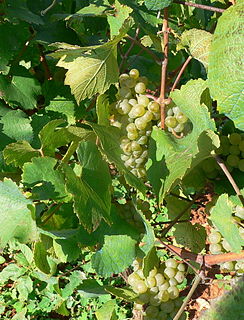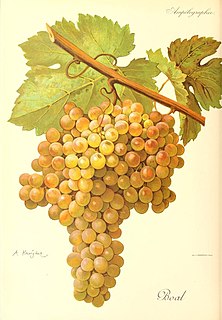Related Research Articles

Malvasia is a group of wine grape varieties grown historically in the Mediterranean region, Balearic Islands, Canary Islands and the island of Madeira, but now grown in many of the winemaking regions of the world. In the past, the names Malvasia, Malvazia, and Malmsey have been used interchangeably for Malvasia-based wines; however, in modern oenology, "Malmsey" is now used almost exclusively for a sweet variety of Madeira wine made from the Malvasia grape. Grape varieties in this family include Malvasia bianca, Malvasia di Schierano, Malvasia negra, Malvasia nera, Malvasia nera di Brindisi, Malvasia di Candia aromatica, Malvasia odorosissima, and a number of other varieties.

Vitis vinifera, the common grape vine, is a species of flowering plant, native to the Mediterranean region, Central Europe, and southwestern Asia, from Morocco and Portugal north to southern Germany and east to northern Iran. There are currently between 5,000 and 10,000 varieties of Vitis vinifera grapes though only a few are of commercial significance for wine and table grape production.

Folle blanche, also known as Picpoule, Gros Plant, and Enrageat blanc, is a wine grape variety from southwest France. It was the traditional grape variety in Cognac and Armagnac production until the 20th century. Folle blanche is an offspring of Gouais blanc, with the other parent so far unidentified.

Tempranillo is a black grape variety widely grown to make full-bodied red wines in its native Spain. Its name is the diminutive of the Spanish temprano ("early"), a reference to the fact that it ripens several weeks earlier than most Spanish red grapes. Tempranillo has been grown on the Iberian Peninsula since the time of Phoenician settlements. It is the main grape used in Rioja, and is often referred to as Spain's noble grape. The grape has been planted throughout the globe's wine regions.
Alvarelhão is a red wine grape grown in northern Portugal.

Trousseau or Trousseau Noir, also known as Bastardo and Merenzao, is an old variety of red wine grape originating in eastern France. It is grown in small amounts in many parts of Western Europe; the largest plantations are today found in Portugal, where most famously it is used in port wine. It makes deep cherry red wines with high alcohol and high, sour candy acidity, and flavours of red berry fruits, often complemented - depending on production - by a jerky nose and an organic, mossy minerality.

Boal is a name given to several varieties of grape cultivated in Portugal, notably in the production of medium-rich fortified wines from Madeira Island. On many wine labels of Madeira wine, the variety's name is anglicized as Bual. Madeira from Bual is typically less sweet than that from Malmsey, but more sweet than Sercial or Verdelho. The vines are also common in Portugal and Spain, where the fruit is used in the same way for fortified wines.

Macabeo, also called Viura or Macabeu, is a white variety of wine grape.

Touriga Nacional is a variety of red wine grape, considered by many to be Portugal's finest. Despite the low yields from its small grapes, it plays a big part in the blends used for ports, and is increasingly being used for table wine in the Douro and Dão. Touriga Nacional provides structure and body to wine, with high tannins and concentrated flavors of black fruit. Jancis Robinson has compared its relationship with Touriga Francesa to the partnership between Cabernet Sauvignon and Cabernet Franc, the former providing structure, the latter filling out the bouquet.

Mencía, known as Jaen in Portugal, is a grape variety native to the western part of the Iberian Peninsula. In Spain, it is planted on over 9,100 hectares, with another 2,500 hectares in neighboring Portugal. It is primarily found in the Bierzo, Ribeira Sacra, Valdeorras, Monterrei and Dão wine regions.

Sezão, formerly known as Souzão, is a Portuguese wine grape that is used in the production of port wine and table wines.

Galician wine is Spanish wine made in the autonomous community of Galicia in the northwest corner of Spain. It includes wine made in the provinces of A Coruña, Ourense, Pontevedra and Lugo. Within Galicia are five Denominacións de Orixe (DO): Monterrei, Rías Baixas, Ribeira Sacra, Ribeiro and Valdeorras. In recent years, the region has seen a resurgence in its wine industry led by the international acclaim being received by the Rías Baixas region for its Albariño wines.

Catalan wines are those that are produced in the wine region of Catalonia. Occasionally, the appellation is applied to some French wine made in the Catalan region of Roussillon also known as Northern Catalonia or the Pays catalans. The city of Barcelona is the capital of Catalonia and despite not being in a wine region it is the focal point of the Catalan wine industry: a primary consumer market, its port provides export functions and a source of financial resources and investment.

Cayetana blanca, also known as Cayetana or Jaén, is a white Spanish wine grape. It is grown mainly in the south of Spain, especially in Extremadura and in the Jerez region where it is distilled for use in brandy production.
Black Spanish was originally assumed to be a seedling of an American hybrid grape which resulted from a crossing of the American Vitis aestivalis species of grape with an unknown Vitis vinifera pollen donor. However, just recently it has been revealed from microsatellite DNA analysis, that the American wild grapevine parent of Black Spanish is Vitis berlandieri and not Vitis aestivalis. This hybridization is not known to have been purposeful, and may have occurred naturally, as was the case with many of the early American grape cultivars. Riaz et al. (2019) have now published the genetic profile of the Jacquez grapevine as follows (percentages): V. vinifera: 69% V. berlandieri: 21% V. rupestris: 7% V. riparia: 3%.
Doña Blanca is a white Spanish and Portuguese grape variety that is grown primarily in the northwest Galicia region of Spain and throughout Portugal from the Douro northward. The variety is a permitted grape in the Spanish Denominación de Origens (DOs) of Valdeorras and Monterrei in Galicia and Bierzo in nearby Castile and León. In Spain, the variety is known as Doña Blanca, while in Portugal it goes mainly by the name Doña Branca. The grapes have thick skins, which do well in the wet maritime climate, but it can also impart some astringency and slight bitterness even with the briefest of skin contact during production due to the high proportion of polyphenols in the skin.
Wine Grapes - A complete guide to 1,368 vine varieties, including their origins and flavours is a reference book about varieties of wine grapes. The book covers all grape varieties that were known to produce commercial quantities of wine at the time of writing, which meant 1,368 of the known 10,000 varieties. It is written by British Masters of Wine Jancis Robinson and Julia Harding in collaboration with Swiss grape geneticist Dr. José Vouillamoz.

Prié blanc is a white Italian wine grape variety that is grown almost exclusively in the Valle d'Aosta DOC of northwest Italy. The Valle d'Aosta varietal wine Blanc de Morgex et de La Salle is made from Prié blanc grapes.
References
- ↑ J. Robinson Jancis Robinson's Guide to Wine Grapes pg 60 Oxford University Press 1996 ISBN 0-19-860098-4
- ↑ Zinelabidine et al. (2012). Identification by SNP analysis of a major role for Cayetana Blanca in the genetic network of Iberian Peninsula grapevine varieties. American Journal of Enology and Viticulture 63 (1) 121-126
- ↑ LACOMBE, T. et al. (2013). Large-scale parentage analysis in an extended set of grapevine cultivars (Vitis vinifera L.). Theoretical and Applied Genetics 126 (2) 401-414
- ↑ "[Catálogos nacionales y comunitarios] - Agricultura - magrama.gob.es".